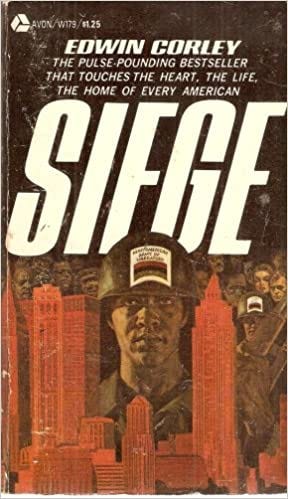More articles on Black dystopian fiction:
Note to readers: Some material in this newsletter includes revised text from my previous paper, The Turner Legacy.
1969 was a banner year for the fictional Black revolution, with no less than six novels addressing Black nationalist violence or revolt in one form or another, including some by White authors. The latter, such as Edwin Corley’s Siege, Fletcher Knebel’s Trespass, Alan Seymour’s The Coming Self-Destruction of the United States of America and Edmund Cooper’s The Last Continent, tended toward pulp fiction. They were less horrifically racist than their early 20th century predecessors—some could charitably be read as well-intentioned—but they were patronizing and full of implicit bias.
Siege, for instance, scans as a semi-woke effort to sell books to Black readers. “At no point does the book suggest that the Negroes have not the motive and the cue for the hatred and violence that color every page,” wrote one journalist in a newspaper column that went on to predict a new and imminent civil war in the real world.[i] Another White journalist claimed, without citing a source, that “most readers of the book automatically and erroneously believe [Corley] to be a Black author.”[ii] Siege’s protagonist is an African-American Army officer, who is portrayed as having very legitimate grievances. But the chief militant turns out to be a Machiavelli, cruelly manipulating the vet through murder and deception into leading a Black nationalist force in the capture of Harlem (an irresistible target for fictional revolutionaries).
But the most important book in the genre, published one month later, was the embodiment of authenticity. The Spook Who Sat by the Door was a 1969 novel by African-American writer Sam Greenlee, a military veteran and former government propagandist, whose overseas experience led him to think about writing “the story of a Third World colonial revolution as it might happen in the United States.”[iii]
Billed (wrongly) on its cover as “the first Black nationalist novel,” the book was as unapologetically militant as it was expertly crafted, and it landed like a meteor strike. The premise: Dan Freeman, the first Black CIA agent, recruited as a token after a politically inspired controversy over the agency’s lack of integration. Freeman is placed in a highly visible post with relatively little responsibility. The title of the book is a layered play on words referring to his job (to literally sit by the door as a visible token of diversity), with the word “spook” serving double-duty, a racial epithet that is also a slang term for a spy.
Freeman’s real agenda, from the very start, is to exploit his CIA training and position to study global insurgencies, then take that knowledge back to the Chicago ghettos where he grew up. He seeds and guides a Black insurgency by recruiting and training gang members, whom he organizes into covert cells that spread out nationally. Attacks that create economic pressure are key to the strategy, in this case with the intent of making “the White man” choose between maintaining racist policies and maintaining the United States as a global superpower.
…by tying up so many of his troops here in the States and stretching him so thin economically that he discovers he can't [fight at home and project power abroad] at the same time. And don't ever think he's not so hooked on messing with us that he won't do anything to keep the scene the way it's always been: us on our ass and him digging it. He could go all the way -- barbed wire, concentration camps, gas ovens; a 'final solution' of the Negro problem.
The book won several awards, including “Book of the Year” from The Sunday Times in London. In 1974, it was adapted as a film. Contemporaneous reviews note that “the film makes it clear that the revolution arose not out of hate toward Whites, but out of love for the Black people and their liberation.”[iv]
Yet hatred for Whites can be found in ample supply in the novel, perhaps moreso than in other examples of the genre, and racial hostility stalks the narrative in unsubtle ways. Greenlee’s depiction of White characters is unsparing and relentlessly negative. Without exception, White people in Spook are either overt racists or just barely covert racists, who drop all pretense as soon as they get behind closed doors. White liberals get the worst of it, depicted as patronizing and cynical, and as deliberately confining even assimilated Blacks to a lower socioeconomic level.
Freeman never encounters a single White person who merits his respect, and no exchange between Freeman and a White character takes place without an expression of hostility and a critical racial commentary, sometimes nuanced, sometimes less so. In 1973, Greenlee told the Washington Post, “Everything in that book is an actual quote. If it wasn’t said to me, I overheard it.”[v]
Freeman tutors the street gangs to rob banks to fund their operations and rob armories to gain access to deadly munitions, suitable for fighting a revolution against the government. The book follows his insurgency through its successful launch, against the backdrop of riots in Chicago. But the narrative ends abruptly in the middle of the revolution, shedding no light on the movement’s tangible goals or its anticipated end game – except, as Freeman argues toward the end of the book, to be left alone. The Spook Who Sat by the Door declines to put a label on its ideology, describing the revolutionaries’ intensive efforts to create propaganda, but giving little insight into its contents.
“What are you?” one of Freeman’s recruits asks, during a discussion of the propaganda plan. “A Muslim, nationalist, Black power advocate? What?”
“Why can’t I just be a man who wants to be free, who wants to walk tall and proud on his own turf as a Black man?” Freeman says. “Why can’t it be as simple as that?”
Despite the deliberate refusal to label its ideology, Spook spends a lot of time on polemics. It presents and dissects a world view in which the White system keeps African-Americans down, allowing them to reach only a token level of success, and then only if they assimilate to the White world and leave their less fortunate brothers and sisters behind. It argues explicitly that the system will only change through violence – not the violence of the mob, but a calculated, competent guerilla war. And that argument was not intended to remain in the literary realm. Thirty years later, Greenlee was frank about the book’s intention. “It’s a training manual for guerrilla warfare,” Greenlee said. “That’s why it scared the White folks so much.”[vi]
Scare them it did. In 1970, a long-simmering pattern of Black nationalist violence suddenly surged and became more strategic. In the wake of the book’s publication, law enforcement officials noted sharp increases in racially motivated bombings and assassinations of police. Both Sons of Darkness, Sons of Light and The Spook Who Sat by the Door had become well-known for their growing popularity among radicals, and both books described tactics that were remarkably similar to trends in militant violence. A September 1970 UPI story on the wave of terrorism noted the popularity of both books among radicals and noted they “may be read as blueprints for guerilla strategy.”[vii] The FBI took an interest as well, opening a secret file on Greenlee and investigating his suspected connections to Black militants. These files remain largely secret today, with only a handful of redacted documents released to the public through the Freedom of Information Act.[viii]
Authors continued to produce Black revolutionary novels well into the 1970s, although none would match Greenlee’s success, either in cultural or literary impact. From the mid-1960s to the mid-1970s, no fewer than 24 books, published short stories or commercial films featured American race wars as a primary plot point, after which they continued to emerge at a slower pace. Most of them were pulpy and forgettable, whether they aimed to exploit White fear or Black enthusiasm. Some were more memorable.
One of the most shocking examples was written by the celebrated Black novelist Chester Himes. An unparalleled prose stylist, the largest part of his corpus is the nine-book Harlem Detective series (1957-1983, which follows two brutal and unyielding police detectives, Grave Digger Jones and Coffin Ed Johnson. In classic cop-story fashion (think Dirty Harry), the partners are often more concerned with justice than following the rules.
Throughout the series, Grave Digger and Coffin Ed often find themselves caught between the racist system they uphold and the interests of the people they are sworn to protect. This tension simmers from the start, and the heat increases steadily throughout the series, most explicitly articulated in its penultimate novel, Blind Man with a Pistol (1967), which finds the police duo struggling to keep the lid on boiling racial tensions.
Himes’ frustration with the intractable racism of American society finally came to a head in the unfinished final novel of the series. Plan B was published in 1983, shortly before the debilitated author’s death, reconstructed by editors from his notes and fragments.[ix] Aptly described as “apocalyptic” by reviewers,[x] the novel finds Grave Digger and Coffin Ed facing a staggeringly violent Black uprising on a countrywide scale. The soaring death toll prompts increasingly genocidal responses from the White power structure that the partners reluctantly serve as part of the police force. Caught between anger at the system and fear that the uprising will result in a genocide of Black people, Grave Digger and Coffin Ed arrive at an impasse that brings the acclaimed series to a close on the grimmest imaginable note.
To be concluded…
[i] CHECK
[ii] Cromie, Robert. “Cromie Looks at Authors and Books.” Chicago Tribune. May 8, 1969.
[iii] http://www.loc.gov/static/programs/national-film-preservation-board/documents/spook%20sat%20door.pdf
[iv] http://www.nathanielturner.com/spookbythedoor.htm
[v] https://www.washingtonpost.com/entertainment/sam-greenlee-whose-movie-the-spook-who-sat-by-the-door-became-a-cult-classic-dies/2014/05/20/3d157e6c-e034-11e3-810f-764fe508b82d_story.html
[vi] https://books.google.com/books?id=AkMEAAAAMBAJ&lpg=PA40&ots=ZKKHAlYSaQ&dq=%E2%80%9CAfter%2030%20years%2C%20a%20Controversial%20Film%20Re-Emerges%E2%80%9D&pg=PA41#v=onepage&q=%E2%80%9CAfter%2030%20years,%20a%20Controversial%20Film%20Re-Emerges%E2%80%9D&f=false
[vii] The Capital Journal (Salem, Oregon) · 8 Sep 1970
[viii] https://www.spyculture.com/after-claiming-they-couldnt-find-it-fbi-release-sam-greenlee-file-thats-more-redacted-than-national-archives-version/
[ix] Plan B cite. Unfinished by Himes, the book was published based on the author’s partially completed draft and a detailed outline.
[x] https://www.publishersweekly.com/978-0-87805-645-3






